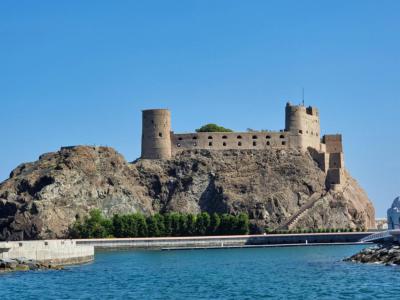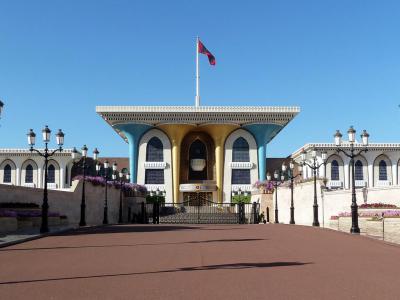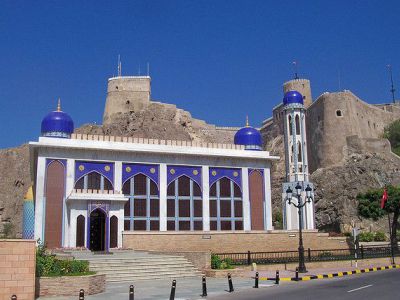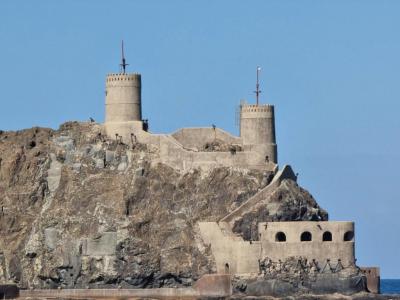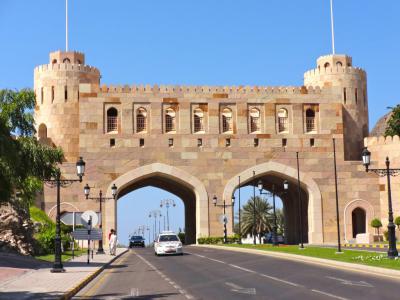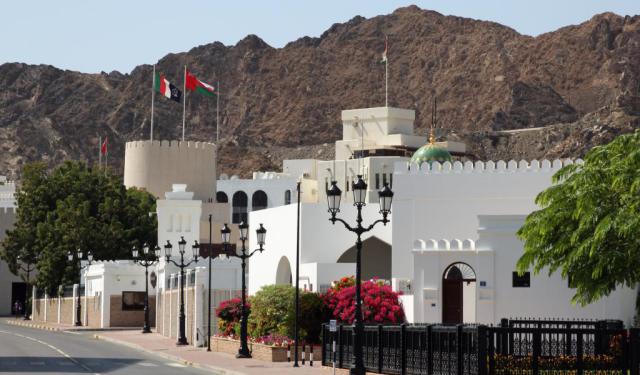
Old Muscat Walking Tour (Self Guided), Muscat
Muscat – nicknamed “The Pearl of Arabia” – is the capital and largest city of Oman. The origin of the name “Muscat” is uncertain; some reckon it is derived from the Arabic word for "anchorage" or "the place of letting fall the anchor", referring to the city's location as a safe harbor for ships.
Sitting at the foot of the Al Hajar Mountains, on the northeastern coast of the Gulf of Oman, Muscat has been known as a major port since the 1st century AD. An important maritime trading hub between Asia, Africa, and Europe, at various points in history, the city has attracted and been ruled by various indigenous and foreign powers, including the Persians, the Portuguese, and the Ottomans.
In the 18th century, under the rule of the Al Said dynasty, Muscat's influence extended as far as East Africa and Zanzibar, and since the ascension of Qaboos bin Said as Sultan of Oman, in 1970, Muscat has experienced rapid infrastructural development paired with vibrant economic growth and establishment of a multi-ethnic society.
The Old Town of Muscat, centered on its crescent-shaped natural harbor, is a world away from the rest of the city. Walking here is like taking a ride in a time machine back to the ancient era. As the historic heart of the capital, this pristine enclave is a hidden gem, full of surprises and secrets waiting to be explored. Among the local highlights are the 16th-century Al Jalili and Al Mirani Forts overlooking the bay; the ceremonial Al Alam Palace, and museums – such as the Muscat Gate Museum and the Bait al Zubair Museum – dedicated to Oman’s history and culture.
"Old Muscat is a treasure trove of Omani heritage," they say. Luckily, to unlock it, one doesn't need to be a pirate. An adventurous traveler, armed with a self-guided walk app like GPSmyCity, can do it just as well.
Sitting at the foot of the Al Hajar Mountains, on the northeastern coast of the Gulf of Oman, Muscat has been known as a major port since the 1st century AD. An important maritime trading hub between Asia, Africa, and Europe, at various points in history, the city has attracted and been ruled by various indigenous and foreign powers, including the Persians, the Portuguese, and the Ottomans.
In the 18th century, under the rule of the Al Said dynasty, Muscat's influence extended as far as East Africa and Zanzibar, and since the ascension of Qaboos bin Said as Sultan of Oman, in 1970, Muscat has experienced rapid infrastructural development paired with vibrant economic growth and establishment of a multi-ethnic society.
The Old Town of Muscat, centered on its crescent-shaped natural harbor, is a world away from the rest of the city. Walking here is like taking a ride in a time machine back to the ancient era. As the historic heart of the capital, this pristine enclave is a hidden gem, full of surprises and secrets waiting to be explored. Among the local highlights are the 16th-century Al Jalili and Al Mirani Forts overlooking the bay; the ceremonial Al Alam Palace, and museums – such as the Muscat Gate Museum and the Bait al Zubair Museum – dedicated to Oman’s history and culture.
"Old Muscat is a treasure trove of Omani heritage," they say. Luckily, to unlock it, one doesn't need to be a pirate. An adventurous traveler, armed with a self-guided walk app like GPSmyCity, can do it just as well.
How it works: Download the app "GPSmyCity: Walks in 1K+ Cities" from Apple App Store or Google Play Store to your mobile phone or tablet. The app turns your mobile device into a personal tour guide and its built-in GPS navigation functions guide you from one tour stop to next. The app works offline, so no data plan is needed when traveling abroad.
Old Muscat Walking Tour Map
Guide Name: Old Muscat Walking Tour
Guide Location: Oman » Muscat (See other walking tours in Muscat)
Guide Type: Self-guided Walking Tour (Sightseeing)
# of Attractions: 7
Tour Duration: 1 Hour(s)
Travel Distance: 2.5 Km or 1.6 Miles
Author: leticia
Sight(s) Featured in This Guide:
Guide Location: Oman » Muscat (See other walking tours in Muscat)
Guide Type: Self-guided Walking Tour (Sightseeing)
# of Attractions: 7
Tour Duration: 1 Hour(s)
Travel Distance: 2.5 Km or 1.6 Miles
Author: leticia
Sight(s) Featured in This Guide:
- National Museum
- Al Jalali Fort
- Al-Alam Royal Palace (Sultan's Palace)
- Al Khor Mosque
- Al Mirani Fort
- Bait Al-Zubair Museum
- Muscat Gate Museum
1) National Museum
Situated in the heart of Muscat, the National Museum of the Sultanate of Oman is a flagship cultural institution that showcases the nation’s heritage from the earliest human settlement in the Oman Peninsula to the present day. Established by a royal decree in 2013, the museum was developed over ten years of collaboration between the Ministry of Heritage and Culture, the Royal Estate Affairs of Oman, Jasper Jacob Associates, and Arts Architecture International Ltd. It opened its doors to the public on July 30, 2016.
The museum boasts an impressive collection of 5,466 objects, including a significant collection of prehistoric metallic artifacts. Its curator, Mouza Sulaiman Mohamed Al-Wardi, is part of an international team exploring the legacy of Oman's silver working tradition, which historically included women as silversmiths.
Designed with state-of-the-art infrastructure, the museum offers 43 digital immersive experiences, a learning center, conservation facilities, an ultra-high definition cinema, and discovery areas for children. One of its unique features is an open-plan museum storage concept, where visitors can learn about the various processes that artifacts go through before they are put on display. The museum is also the first in the Middle East to adopt Arabic Braille script for the visually impaired, and it provides integrated infrastructure for special needs.
The purpose-built museum building spans 13,700 square meters (147,000 square feet), including 4,000 square meters (43,000 square feet) dedicated to 14 permanent galleries, and an additional 400 square meters (4,300 square feet) for temporary exhibitions. With its impressive collection, modern facilities, and commitment to accessibility, the National Museum of the Sultanate of Oman is a must-visit destination for anyone interested in Oman's rich cultural heritage.
The museum boasts an impressive collection of 5,466 objects, including a significant collection of prehistoric metallic artifacts. Its curator, Mouza Sulaiman Mohamed Al-Wardi, is part of an international team exploring the legacy of Oman's silver working tradition, which historically included women as silversmiths.
Designed with state-of-the-art infrastructure, the museum offers 43 digital immersive experiences, a learning center, conservation facilities, an ultra-high definition cinema, and discovery areas for children. One of its unique features is an open-plan museum storage concept, where visitors can learn about the various processes that artifacts go through before they are put on display. The museum is also the first in the Middle East to adopt Arabic Braille script for the visually impaired, and it provides integrated infrastructure for special needs.
The purpose-built museum building spans 13,700 square meters (147,000 square feet), including 4,000 square meters (43,000 square feet) dedicated to 14 permanent galleries, and an additional 400 square meters (4,300 square feet) for temporary exhibitions. With its impressive collection, modern facilities, and commitment to accessibility, the National Museum of the Sultanate of Oman is a must-visit destination for anyone interested in Oman's rich cultural heritage.
2) Al Jalali Fort
Al Jalali Fort is a historic castle located in the city of Muscat. The fort was built during the 16th century by the Portuguese and served as a military stronghold to protect the city from invaders. Today, it is one of the most popular tourist destinations in Oman and offers visitors a glimpse into the country's rich history.
The fort is situated on a rocky outcrop overlooking the Gulf of Oman and is accessible only by a steep staircase that leads up to its entrance. Despite its small size, the fort is well-fortified and boasts thick walls, towers, and cannons. The fort has been well-maintained over the centuries, and its current state is a testament to the craftsmanship of the Portuguese builders.
Al Jalali Fort has served many purposes over the centuries. It was used as a military base by the Portuguese, and later by the Omanis. In the 20th century, the fort was converted into a prison and remained so until 1970. Today, the fort is open to the public and is home to a museum that showcases Omani culture and history. The museum exhibits a range of artifacts, including traditional clothing, jewelry, and weapons, and provides visitors with an opportunity to learn about the rich cultural heritage of Oman.
Visitors to Al Jalali Fort can enjoy stunning views of the Gulf of Oman and the surrounding landscape. The fort is also a popular spot for photography, with many visitors capturing memorable photos of the fort and its surroundings. The fort is a must-visit destination for anyone interested in history and architecture, and it provides a unique glimpse into Oman's past.
The fort is situated on a rocky outcrop overlooking the Gulf of Oman and is accessible only by a steep staircase that leads up to its entrance. Despite its small size, the fort is well-fortified and boasts thick walls, towers, and cannons. The fort has been well-maintained over the centuries, and its current state is a testament to the craftsmanship of the Portuguese builders.
Al Jalali Fort has served many purposes over the centuries. It was used as a military base by the Portuguese, and later by the Omanis. In the 20th century, the fort was converted into a prison and remained so until 1970. Today, the fort is open to the public and is home to a museum that showcases Omani culture and history. The museum exhibits a range of artifacts, including traditional clothing, jewelry, and weapons, and provides visitors with an opportunity to learn about the rich cultural heritage of Oman.
Visitors to Al Jalali Fort can enjoy stunning views of the Gulf of Oman and the surrounding landscape. The fort is also a popular spot for photography, with many visitors capturing memorable photos of the fort and its surroundings. The fort is a must-visit destination for anyone interested in history and architecture, and it provides a unique glimpse into Oman's past.
3) Al-Alam Royal Palace (Sultan's Palace)
Situated in Old Muscat, the Al Alam Palace served as a ceremonial palace for Sultan Qaboos bin Said Al Said. The palace, which has a facade adorned with gold and blue, has a rich history of over two centuries, having been built under the supervision of Imam Sultan bin Ahmed, the 7th direct great-grandfather of Sultan Haitham.
In 1972, the palace was reconstructed to serve as a royal residence. While the palace's inner grounds remain off-limits to the public, visitors are permitted to take photographs near the gates. The Mirani and Jalali Forts, constructed by the Portuguese in the 16th century, surround the Al Alam Palace.
The palace is used for official events and plays host to notable guests. During her state visit to Oman in January 2012, Queen Beatrix of the Netherlands was received by the sultan at the Al Alam Palace.
Renowned author Peter J. Ochs described the palace as "elegant but humble in design, unlike the grandiose structures of other capitals," when visitors approach the palace gates. The palace's highly polished marble surfaces add to its elegance. Government buildings nearby follow the traditional Omani style with white exteriors, crenelated rooftops, and wooden balconies. Although primarily a ceremonial palace, a guest villa within the palace's grounds features its own pool, spa, and walled gardens.
In 1972, the palace was reconstructed to serve as a royal residence. While the palace's inner grounds remain off-limits to the public, visitors are permitted to take photographs near the gates. The Mirani and Jalali Forts, constructed by the Portuguese in the 16th century, surround the Al Alam Palace.
The palace is used for official events and plays host to notable guests. During her state visit to Oman in January 2012, Queen Beatrix of the Netherlands was received by the sultan at the Al Alam Palace.
Renowned author Peter J. Ochs described the palace as "elegant but humble in design, unlike the grandiose structures of other capitals," when visitors approach the palace gates. The palace's highly polished marble surfaces add to its elegance. Government buildings nearby follow the traditional Omani style with white exteriors, crenelated rooftops, and wooden balconies. Although primarily a ceremonial palace, a guest villa within the palace's grounds features its own pool, spa, and walled gardens.
4) Al Khor Mosque
One of the oldest and most stunning mosques in Oman is the Al-Khor Mosque. Its exact date of construction is unknown, but it was formerly known as the Mosque of Martyrs. This is due to the numerous funeral prayers held there for Omanis who lost their lives in the 17th and 18th centuries while defending their country against Portuguese invaders. Al-Khor Mosque is situated near Al-Alam Palace on the palace's seaside.
Today, the mosque's official name is derived from the name of the inland gulfs of water that are created when tidal waves crash against the rocky coast of Muscat. It is also known as the Family Mosque since senior members of the Omani royal family pray there. Al-Khor Mosque has been renovated many times by different Sultans, most recently in 1980 by Sultan Qaboos.
What sets Al-Khor Mosque apart is its extensive use of tinted glass for most of its outer walls, complemented by white marble, blue and brown tiles, and golden scripts of the Holy Quran. During the day, the interior of the mosque showcases the beauty of the tinted glass. The ceiling features Arabic calligraphy of the ninety-nine divine names of Allah, each encrusted in gold over a square tile of blue and white. The centerpiece of the mosque is a minimal crystal chandelier that smoothly descends in the middle of the main prayer hall. Interestingly, the mosque does not have a central upper dome, a common feature in most Omani mosques.
Al-Khor Mosque is a hidden gem in Old Muscat that visitors may overlook. It is located behind Al-Alam Palace and near Al-Mirani Fort. To get to the mosque, you must pass through the old gate going towards the Omani French Museum and continue down the street until you see the mosque on the left side of the road. A visit to Al-Khor Mosque can be a peaceful way to conclude a tour of the area around Al-Alam Palace.
Today, the mosque's official name is derived from the name of the inland gulfs of water that are created when tidal waves crash against the rocky coast of Muscat. It is also known as the Family Mosque since senior members of the Omani royal family pray there. Al-Khor Mosque has been renovated many times by different Sultans, most recently in 1980 by Sultan Qaboos.
What sets Al-Khor Mosque apart is its extensive use of tinted glass for most of its outer walls, complemented by white marble, blue and brown tiles, and golden scripts of the Holy Quran. During the day, the interior of the mosque showcases the beauty of the tinted glass. The ceiling features Arabic calligraphy of the ninety-nine divine names of Allah, each encrusted in gold over a square tile of blue and white. The centerpiece of the mosque is a minimal crystal chandelier that smoothly descends in the middle of the main prayer hall. Interestingly, the mosque does not have a central upper dome, a common feature in most Omani mosques.
Al-Khor Mosque is a hidden gem in Old Muscat that visitors may overlook. It is located behind Al-Alam Palace and near Al-Mirani Fort. To get to the mosque, you must pass through the old gate going towards the Omani French Museum and continue down the street until you see the mosque on the left side of the road. A visit to Al-Khor Mosque can be a peaceful way to conclude a tour of the area around Al-Alam Palace.
5) Al Mirani Fort
The fortification known as Al-Mirani Fort can be found in the harbor of Old Muscat. Originally constructed before the Portuguese invasion, it was later reconstructed by the Portuguese in 1587. Notably, Al-Mirani Fort was the first to utilize cannons in Oman.
Al-Mirani Fort holds an important place in history due to its involvement in the downfall of the Portuguese. According to legend, the Portuguese commander had fallen in love with the daughter of a Hindu supplier. However, the supplier refused the match due to religious reasons. When threatened with ruin, the supplier spent a year preparing for the wedding and convinced the commander that the fort's supplies needed to be replenished. He gradually removed all of the fort's gunpowder and grain until it was defenseless. The Omani imam, Sultan Bin Saif, then retook the fort in 1649, ousting the Portuguese from Muscat soon after. Although the wedding never took place, the fort played a crucial role in the Portuguese defeat.
Al-Mirani Fort is a significant tourist attraction in Oman due to its historical importance and stunning architecture. Despite being closed to the public, its imposing presence in the harbor contributes to the iconic view of Muscat that has been captured in 19th-century lithographs.
Al-Mirani Fort holds an important place in history due to its involvement in the downfall of the Portuguese. According to legend, the Portuguese commander had fallen in love with the daughter of a Hindu supplier. However, the supplier refused the match due to religious reasons. When threatened with ruin, the supplier spent a year preparing for the wedding and convinced the commander that the fort's supplies needed to be replenished. He gradually removed all of the fort's gunpowder and grain until it was defenseless. The Omani imam, Sultan Bin Saif, then retook the fort in 1649, ousting the Portuguese from Muscat soon after. Although the wedding never took place, the fort played a crucial role in the Portuguese defeat.
Al-Mirani Fort is a significant tourist attraction in Oman due to its historical importance and stunning architecture. Despite being closed to the public, its imposing presence in the harbor contributes to the iconic view of Muscat that has been captured in 19th-century lithographs.
6) Bait Al-Zubair Museum (must see)
Bait Al Zubair Museum, established in 1998, is a cultural and heritage center that showcases the finest privately owned collection of Omani artifacts belonging to the Zubair family. The center has grown significantly since its inception, and it now boasts one of the most extensive heritage and permanent art collections in Oman. Bait Al Zubair offers an authentic insight into Oman's rich cultural heritage and is recognized by international museums and art galleries as a valuable learning and research resource on Omani heritage.
The complex, which includes six separate buildings and a garden with a miniature Omani village, an aflaj system, and a variety of indigenous plants and trees, is a serene and beautiful place to visit. The buildings themselves are as much a part of the collection as the thousands of artifacts on display.
Bait Al Zubair Museum houses a carefully curated, ever-evolving private collection that reflects Oman's cultural heritage and unique identity. The collection features traditional Omani weaponry, jewelry, costume, household utensils, and furniture, as well as early European maps and prints of the Arabian Peninsula and East Africa, early photographs, satellite images, coins, stamps, musical instruments, documents, manuscripts, and books.
The complex, which includes six separate buildings and a garden with a miniature Omani village, an aflaj system, and a variety of indigenous plants and trees, is a serene and beautiful place to visit. The buildings themselves are as much a part of the collection as the thousands of artifacts on display.
Bait Al Zubair Museum houses a carefully curated, ever-evolving private collection that reflects Oman's cultural heritage and unique identity. The collection features traditional Omani weaponry, jewelry, costume, household utensils, and furniture, as well as early European maps and prints of the Arabian Peninsula and East Africa, early photographs, satellite images, coins, stamps, musical instruments, documents, manuscripts, and books.
7) Muscat Gate Museum
Situated in the heart of Old Muscat, the Muscat Gate Museum first opened its doors in January 2001. The museum showcases Oman's rich history from the Neolithic era to the present day and features numerous special exhibits on Muscat's water sources, including ancient wells, underground channels, souqs, houses, mosques, harbors, and forts.
Nestled above the Muscat Modern Gate, the museum offers a breathtaking view, accessible via a grand staircase leading up to its entrance. It provides visitors with an immersive experience of Oman's extensive history, with a particular focus on the capital city of Muscat. Guests can learn about the renowned Falaj irrigation system and the unique architecture of Oman, including the intricate niches found in mosques, halls, doors, and wooden arches.
The Muscat Gate Museum takes visitors on a captivating journey through the city's growth and development, from its origins as a bustling port to its status as a thriving capital. As a witness to Muscat's relics and history, the museum offers a comprehensive exploration of the city's fascinating past.
Nestled above the Muscat Modern Gate, the museum offers a breathtaking view, accessible via a grand staircase leading up to its entrance. It provides visitors with an immersive experience of Oman's extensive history, with a particular focus on the capital city of Muscat. Guests can learn about the renowned Falaj irrigation system and the unique architecture of Oman, including the intricate niches found in mosques, halls, doors, and wooden arches.
The Muscat Gate Museum takes visitors on a captivating journey through the city's growth and development, from its origins as a bustling port to its status as a thriving capital. As a witness to Muscat's relics and history, the museum offers a comprehensive exploration of the city's fascinating past.
Walking Tours in Muscat, Oman
Create Your Own Walk in Muscat
Creating your own self-guided walk in Muscat is easy and fun. Choose the city attractions that you want to see and a walk route map will be created just for you. You can even set your hotel as the start point of the walk.
Muttrah Seaside Walking Tour
Muttrah is a port district of Oman's capital and one of the most historic areas in Muscat, formerly a major commercial hub, boasting one of the largest harbors and sea ports in the region. The area is sometimes lovingly referred to as "the bride of Muscat", most likely for its traditional architecture or the stunning views of the Gulf of Oman, altogether contributing to the capital... view more
Tour Duration: 1 Hour(s)
Travel Distance: 2.4 Km or 1.5 Miles
Tour Duration: 1 Hour(s)
Travel Distance: 2.4 Km or 1.5 Miles
The Most Popular Cities
/ view all

